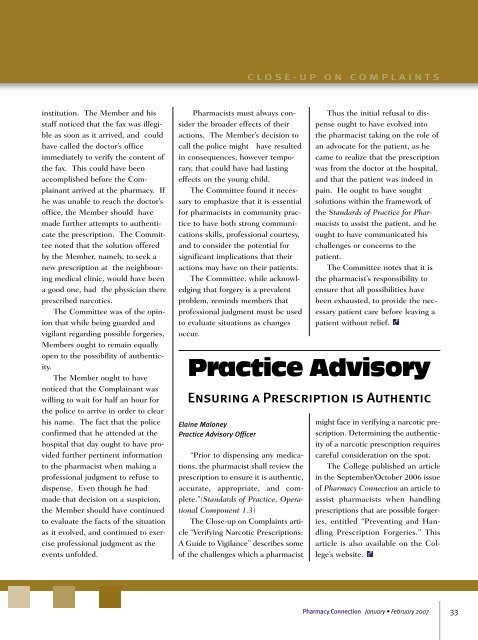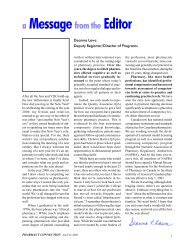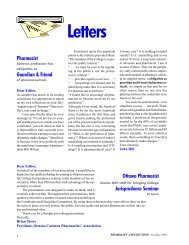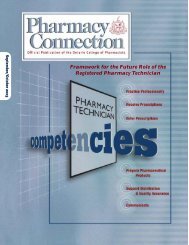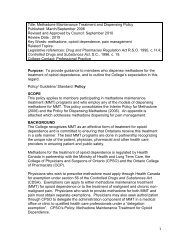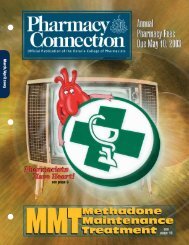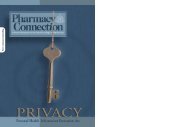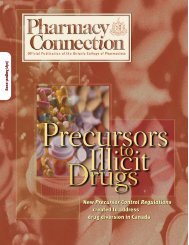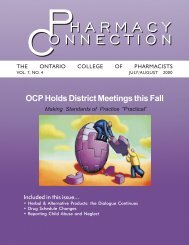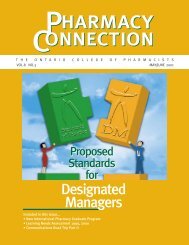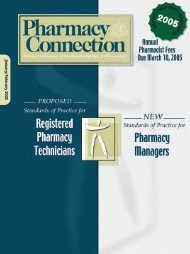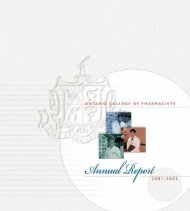INSIDE: - Ontario College of Pharmacists
INSIDE: - Ontario College of Pharmacists
INSIDE: - Ontario College of Pharmacists
Create successful ePaper yourself
Turn your PDF publications into a flip-book with our unique Google optimized e-Paper software.
C L O S E - U P O N C O M P L A I N T S<br />
institution. The Member and his<br />
staff noticed that the fax was illegible<br />
as soon as it arrived, and could<br />
have called the doctor’s <strong>of</strong>fice<br />
immediately to verify the content <strong>of</strong><br />
the fax. This could have been<br />
accomplished before the Complainant<br />
arrived at the pharmacy. If<br />
he was unable to reach the doctor’s<br />
<strong>of</strong>fice, the Member should have<br />
made further attempts to authenticate<br />
the prescription. The Committee<br />
noted that the solution <strong>of</strong>fered<br />
by the Member, namely, to seek a<br />
new prescription at the neighbouring<br />
medical clinic, would have been<br />
a good one, had the physician there<br />
prescribed narcotics.<br />
The Committee was <strong>of</strong> the opinion<br />
that while being guarded and<br />
vigilant regarding possible forgeries,<br />
Members ought to remain equally<br />
open to the possibility <strong>of</strong> authenticity.<br />
The Member ought to have<br />
noticed that the Complainant was<br />
willing to wait for half an hour for<br />
the police to arrive in order to clear<br />
his name. The fact that the police<br />
confirmed that he attended at the<br />
hospital that day ought to have provided<br />
further pertinent information<br />
to the pharmacist when making a<br />
pr<strong>of</strong>essional judgment to refuse to<br />
dispense. Even though he had<br />
made that decision on a suspicion,<br />
the Member should have continued<br />
to evaluate the facts <strong>of</strong> the situation<br />
as it evolved, and continued to exercise<br />
pr<strong>of</strong>essional judgment as the<br />
events unfolded.<br />
<strong>Pharmacists</strong> must always consider<br />
the broader effects <strong>of</strong> their<br />
actions. The Member’s decision to<br />
call the police might have resulted<br />
in consequences, however temporary,<br />
that could have had lasting<br />
effects on the young child.<br />
The Committee found it necessary<br />
to emphasize that it is essential<br />
for pharmacists in community practice<br />
to have both strong communications<br />
skills, pr<strong>of</strong>essional courtesy,<br />
and to consider the potential for<br />
significant implications that their<br />
actions may have on their patients.<br />
The Committee, while acknowledging<br />
that forgery is a prevalent<br />
problem, reminds members that<br />
pr<strong>of</strong>essional judgment must be used<br />
to evaluate situations as changes<br />
occur.<br />
Thus the initial refusal to dispense<br />
ought to have evolved into<br />
the pharmacist taking on the role <strong>of</strong><br />
an advocate for the patient, as he<br />
came to realize that the prescription<br />
was from the doctor at the hospital,<br />
and that the patient was indeed in<br />
pain. He ought to have sought<br />
solutions within the framework <strong>of</strong><br />
the Standards <strong>of</strong> Practice for <strong>Pharmacists</strong><br />
to assist the patient, and he<br />
ought to have communicated his<br />
challenges or concerns to the<br />
patient.<br />
The Committee notes that it is<br />
the pharmacist’s responsibility to<br />
ensure that all possibilities have<br />
been exhausted, to provide the necessary<br />
patient care before leaving a<br />
patient without relief.<br />
Practice Advisory<br />
Ensuring a Prescription is Authentic<br />
Elaine Maloney<br />
Practice Advisory Officer<br />
“Prior to dispensing any medications,<br />
the pharmacist shall review the<br />
prescription to ensure it is authentic,<br />
accurate, appropriate, and complete.”(Standards<br />
<strong>of</strong> Practice, Operational<br />
Component 1.3)<br />
The Close-up on Complaints article<br />
“Verifying Narcotic Prescriptions:<br />
A Guide to Vigilance” describes some<br />
<strong>of</strong> the challenges which a pharmacist<br />
might face in verifying a narcotic prescription.<br />
Determining the authenticity<br />
<strong>of</strong> a narcotic prescription requires<br />
careful consideration on the spot.<br />
The <strong>College</strong> published an article<br />
in the September/October 2006 issue<br />
<strong>of</strong> Pharmacy Connection an article to<br />
assist pharmacists when handling<br />
prescriptions that are possible forgeries,<br />
entitled “Preventing and Handling<br />
Prescription Forgeries.” This<br />
article is also available on the <strong>College</strong>’s<br />
website.<br />
Pharmacy Connection January • February 2007 33


